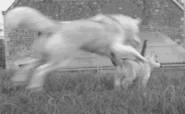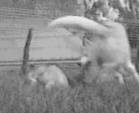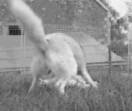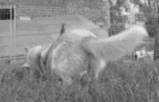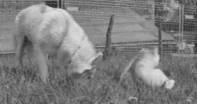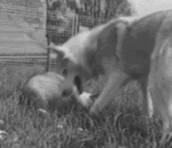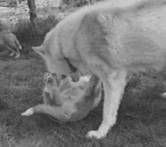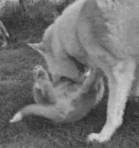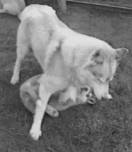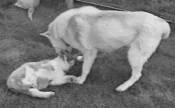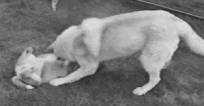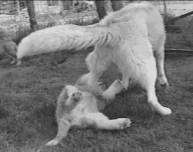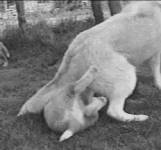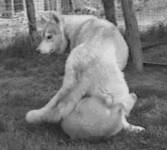The mother-puppy educational relationship
Dr Joël Dehasse, Brussels, Belgium.
Lecture given at the 2nd World Ethology Meeting, Lyon, France, Sept. 22, 1999
Introduction
I observed and videotaped husky mothers with their puppies from birth to 3 months of age. One of the interactions I observed may well be an important education step in the learning of self-control and submissive posture.
Limitations
I will limit myself to two specific interactions. The first one is the learning of the submission posture. In the second the mother runs toward the puppy and puts and
keeps it down.
Description of the learning of the submission posture
Several years ago, I hypothesised that the position used by the puppy when licked by its mother when she was cleaning it and activating the elimination reflex would become the ritualised submission position used to stop an agonistic behaviour as a grown up
dog. This hypothesis has been proved by P. Pageat (95, 98) using orphan puppies in which the elimination reflex was activated in dorsal or ventral decubitus. The posture used to activate the elimination reflex is evolving into the effective ritual posture of
submission by the puppy afterwards.
Description of the “put & keep down” (PKD) interaction
I observed a specific interaction between several Husky mothers and their puppies. I am hypothesising that this interaction is a way to teach the puppy to stop any behaviour and use the inhibited decubitus posture to stop the interaction with an adult. I also
observed this sequence in a Labrador mother.
This is the sequence.
The mother chooses a puppy. The choice seems to be aleatory. It is not always the boisterous pup, it may even be the losing pup in a tug of war between puppies. She keeps the same pup “in mind” for 15 to 30 minutes. She moves on it, pushes it on the ground
aiming with her mouth to the forehand part of the puppy, never grabbing nor shaking it but pushing parts of the ear, neck, nape, head or muzzle deep in her mouth and bending forward so the puppy is unable to come up and is forced to lie down.
When the puppy lies down on its belly or on its flank or back, she stops moving, looks at it and waits until it moves again.
If it is moving, she may grab its belly in her teeth. If it is urinating, she licks its belly. Then she stays bending forward, waiting for the puppy to move. If it moves, she starts the procedure again. If it does not move, she goes away. The puppy resumes its
activities or runs following its mother. The mother may start the procedure right away or wait for a few minutes.
I have seen, but really not often, that she may sit on the puppy to keep it down.
Modelisation of the “put & keep down” behaviour
The mother or another adult selects a puppy, goes for it, and pushes it to the ground until it stays unmoving for an increasing length of time.
This behaviour seems to be a continuation of the liking of the perineum by the mother, behaviour hypothesised and demonstrated as a teaching by an adult to the puppy to acquire the submissive posture. Teaching this behaviour is important for the communication,
between dogs and to solve and stop agonistic encounters.
I hypothesise that this behaviour teaches the puppy to control itself: it does mean “being able to stop a sequence of acts and to stay unmoving”. If this hypothesis is correct, then this teaching is very important to prevent overactivity.
Behavioural modalities affecting the “put & keep down” (PKD) behaviour
Any pathology affecting the mother behaviour may increase the risk that she does not produce the PKD behaviour. It may be a mother with incorrect socialisation to her own species, not recognising totally her puppies as her own species and trying to avoid them
or aggress them. All kinds of anxieties or depressive or variable (dysthymic) moods may produce the same results.
The kennel management may have a lot of influence. When the mother is separated early from her puppies, it induces the same lack of PKD behaviour.
Behavioural pathologies correlated by a lack of “put & keep down” (PKD) behaviour
Two pathologies may be induced by the lack of PKD behaviour teaching: primary dyssocialisation (Pageat) and overactivity.
Primary dyssocialisation (as described by P. Pageat 95, 98): puppies over 8 weeks of age, or juvenile dogs
These dogs may become very dangerous, being unable to stop any agonistic communication by adequate submission, appeasing or even dominance postures. These dogs may
evolve toward hyperaggression.
Overactivity: see Dehasse:
Clinical management of stereotypies and overactivity in dogs
.
Treatment of pathologies affected by a lack of “put & keep down” behaviour
The best therapy is to teach the dog how to behave adequately with the use of the submission attitudes, postures and behaviours. At the earliest stage of the pathology, the easiest way is to put this dog with a big, heavy, very controlled dominant dog and make
them live together for a few days. The dominant dog will teach the young dog how to behave.
If this is not a possibility, the owners will have to teach the dog to use the lying-on-the-back-without-moving posture. They will have to do as the mother should have done, putting the dog in this posture, without any anger, several times a day, until it is
quieted.
When the pathology is installed for a few months, medication may be necessary. Inhibiting aggression via a serotonine selective reuptake inhibitor (SSRI) is a possibility. My choice is to use fluvoxamine at 0,5 to 2 mg per kilo twice a day. Other medications
are possible.
Conclusions
What one thought was innate behaviours like the submission posture and the control of one’s psychomotoric activity may well be taught by the mother or another canine adult. The lack of this education may result in pathologies of the communication and of the
ability to cope with - and resolve - adequately agonistic behaviours.
Bibliography
Pageat P. Pathologie du comportement du chien. Editions du Point Vétérinaire, Paris, 1995. 2ème édition 1998.
Key words
Dyssocialisation, Overactivity, Submission posture, Submission ritual, Teaching,
Author.
Dr Joël Dehasse, Brussels (tel./fax 00 32 2 7704008 - joel.dehasse@skynet.be
)
Dr Joël Dehasse
|
||||||||||||||||
|
2005-02-02
|
